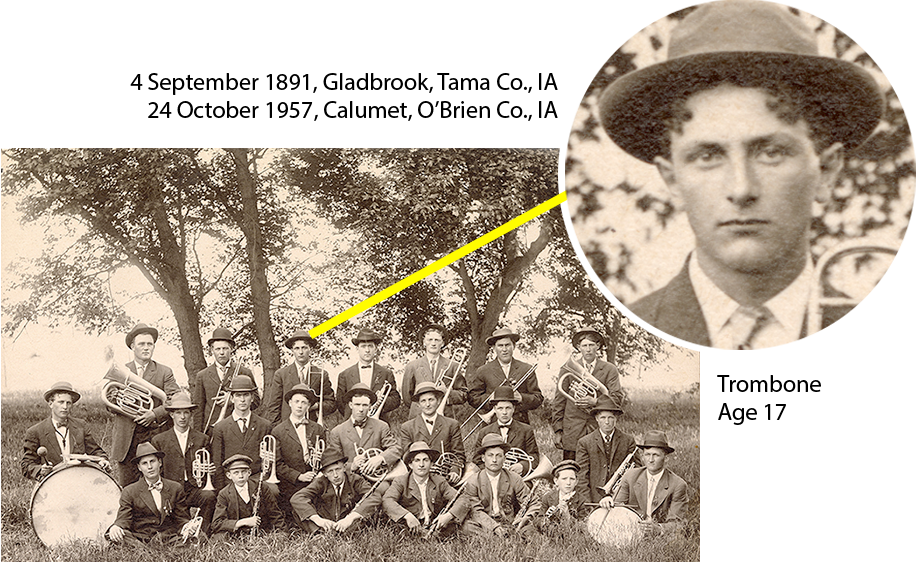
Albert Mehrens (no middle name) was a son of Claus Mehrens (1847-1924) and Mathilda Schmidt (1857-1924).(1) He and his older brother John Mehrens (1889-1941), also a Calumet German Band member, grew up on the family farm in Liberty Township, O’Brien County. As noted on other band member bios, Albert and John Mehrens were one of three sets of brothers who were in the band. The others were Harry Rochel (1883-1965) and Charles Rochel (1888-1967), and William Shafer (1888-1954) and Ernest Shafer (1891-1964). In other words, six of the 22 band members comprised pairs of siblings.
Like many other band members’ families, the Mehrenses reflected a typical migration pattern for German immigrants of this era. Claus was born in Schleswig-Holstein. After emigration, he settled first in Tama County, Iowa, in the east central part of the state. Many German immigrants of the late 19th century ended their journey or laid over in Scott County because the passenger railroad crossed the Mississippi River there. Some families remained in Scott County or moved on to Tama, the locus of a strong German community, or they moved further west, to northwest Iowa or the Dakotas.
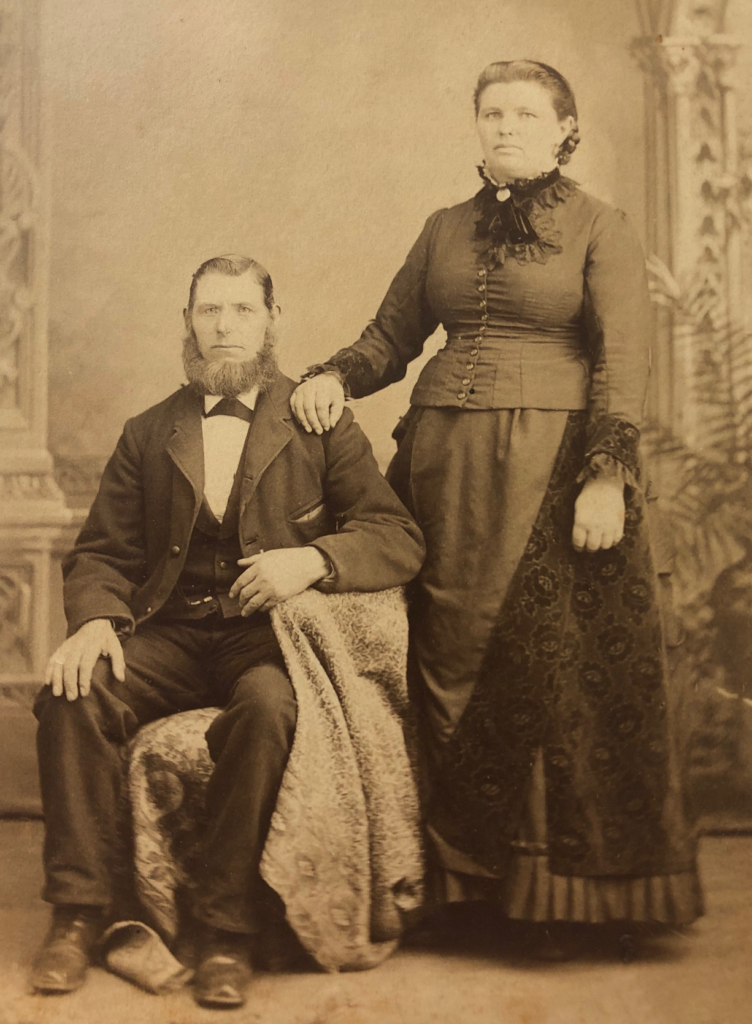
The Mehrens family also reflected an all-too-common pattern of family life in this era: a youthful marriage, the early death of a young spouse, remarriage, and the forming of a second family. In 1870, Claus married Katharina Schmidt (1849-1881) in Scott County, who was another immigrant from Schleswig-Holstein. They had four children: Henry Claus (1870-1922), Emma (1875-1936), Gustave Henry (1880-1932), and Agnes (1880-1935). (Agnes was born a mere nine months after Gustave — Gustave in January and Agnes in October.) But Katharina died in 1881, at age 32, leaving Claus with four young children. His remarriage, on 10 January 1882, was to Katharina’s younger sister, Mathilda.
Claus continued to farm in Tama County for several years after this marriage, and two more children — John and Albert — were born there. But the family then moved, in 1894, to O’Brien County. The Mehrens farm was in Section 8 of Liberty Township, northwest of Calumet. There another son, Elmer (1897-1955), was born. By the 1900 census, the two older children had left the household, and five siblings and half-siblings remained: Gustave, Agnes, John, Albert, and Elmer. In 1909, when the Calumet German Band photo was taken, Albert and John were still part of the household. By 1920, Claus and Mathilda had retired to the town of Calumet, and the Mehrens farm operation continued under Albert.
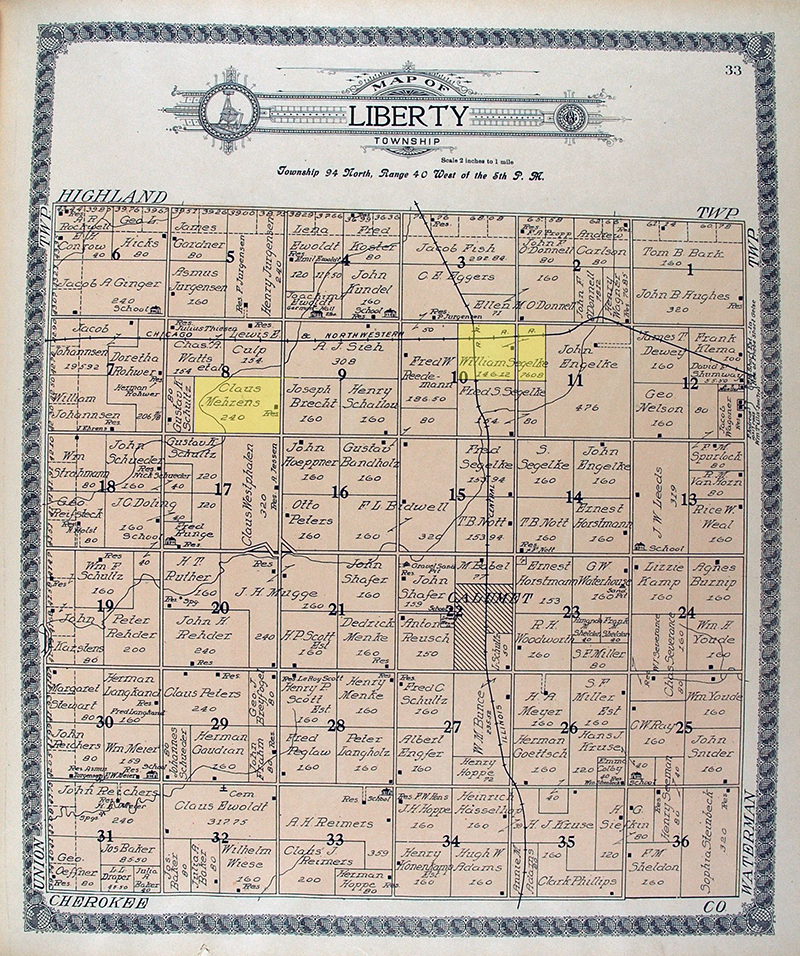
Albert married Mayme [MAY-mee] Anna Segelke (1892-1975) on 1 October 1913 in Sutherland. Mayme had been raised on a farm just two miles away from the Mehrens farm. Like so many other band member families, Mayme’s parents — William S. Segelke (1865-1949) and Mary Anna Wilhelmine Harms (1868-1945) — had been born in Germany. Mayme was one of seven children, six of whom were girls; her siblings were Elle Nora (1889-1974), Mabel Amanda (1891-1946), Alma (1894-1930), Lena (1896-1974), Harry S. (1897-1973), and Lucena Mathilda Caroline (1904-1948).
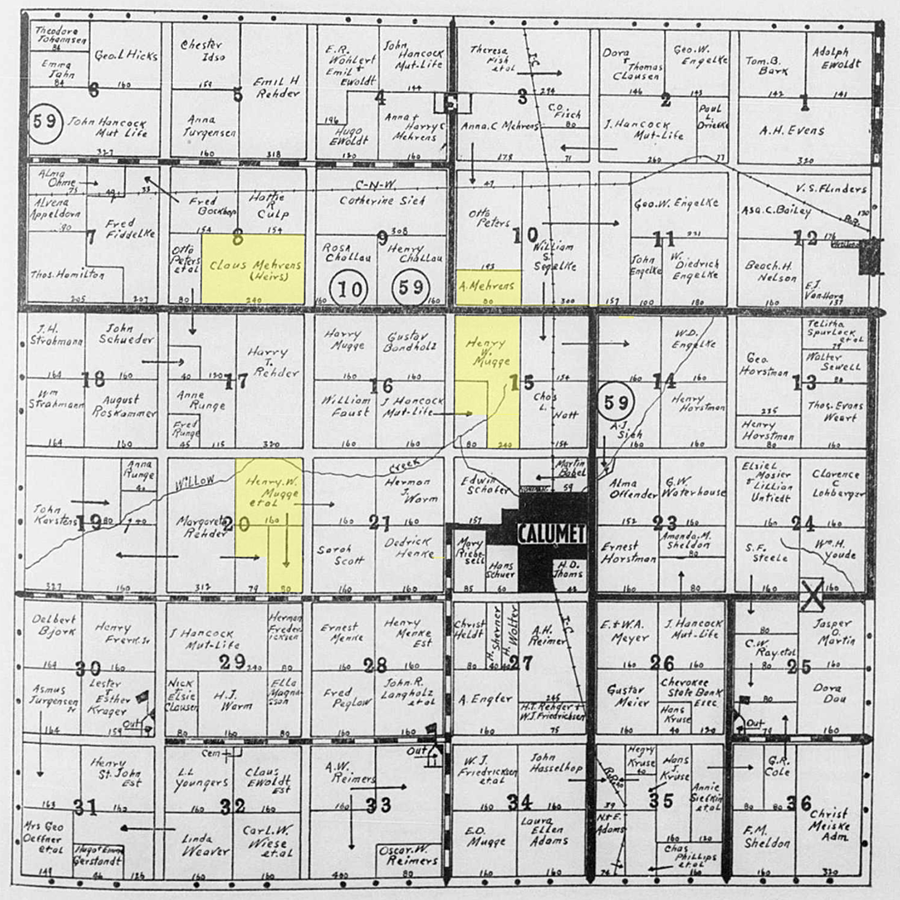
Albert Mehrens is one of several band members who carried on the farming tradition of their immigrant families. As noted above, at the time of this 1909 photo Albert was helping his father with the family farm, and upon Claus’s retirement Albert continued to farm there, subsequently acquiring additional land nearby. On a 1940 plat map, part of the Mehrens farm operation is seen as directly across the road from that of Albert’s bandmate Henry W. Mugge (1891-1967).
The birth of three girls quickly followed the 1913 marriage of Albert and Mayme: Mildred Mae (1914-1991), Neva (1916-2012), and Mary Ann (1919-1986). The Mehrens family was actively involved in the social and civic life of Calumet and its environs. Albert served on the Calumet town council throughout the 1930s and 1940s, and news items about the family’s social activities and other comings and goings appeared regularly in the local newspaper during these decades.
Two of Albert’s additional roles in the life of the region are historically interesting. First, beginning in November 1937, he was named by the state Department of Agriculture to serve as a “corn sealer” for Liberty Township. This role was connected to a federal loan program at the time for farmers, which also helped to provide price stability in the market. To ensure that corn can be stored without fear of spoilage, it must have as little moisture content as possible, and it often is tested for this purpose.(2) The federal program relied on farmers’ stored corn as collateral for loans (the grain could also be simply transferred to the government), and the program thus required local representatives to procure samples of cribbed corn for testing by state labs. Cribs of corn were then “sealed” (i.e., affixed with program signage) to warrant program participation and compliance. Similar programs under various agencies have continued into the 21st century.
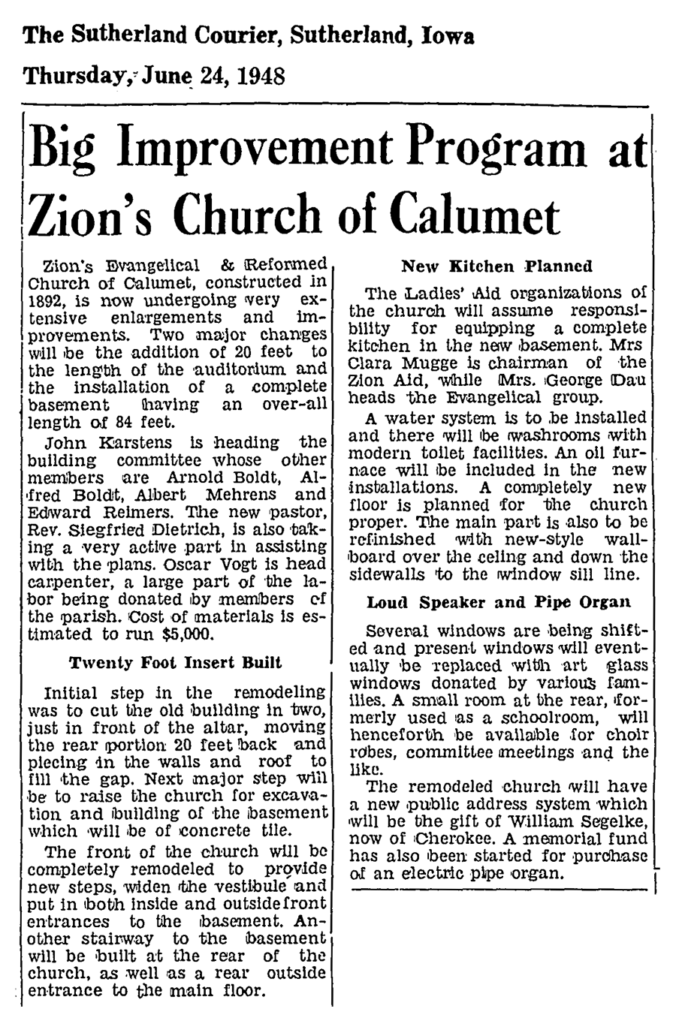
Second, like many other band members, the Mehrenses were also very much involved in the life of the German Lutheran church community in Calumet (Zion Evangelical and Reformed Church(3)), and in 1948 the church was remodeled and expanded. Albert Mehrens served on the building committee for this expansion, which was done in an unusual way: the church was cut in two, with one part moved 20 feet to accommodate a pieced-in extension. The building was then lifted off its foundations while excavation and construction took place to fit out the church with a basement, which housed (and continues to house) a social hall.
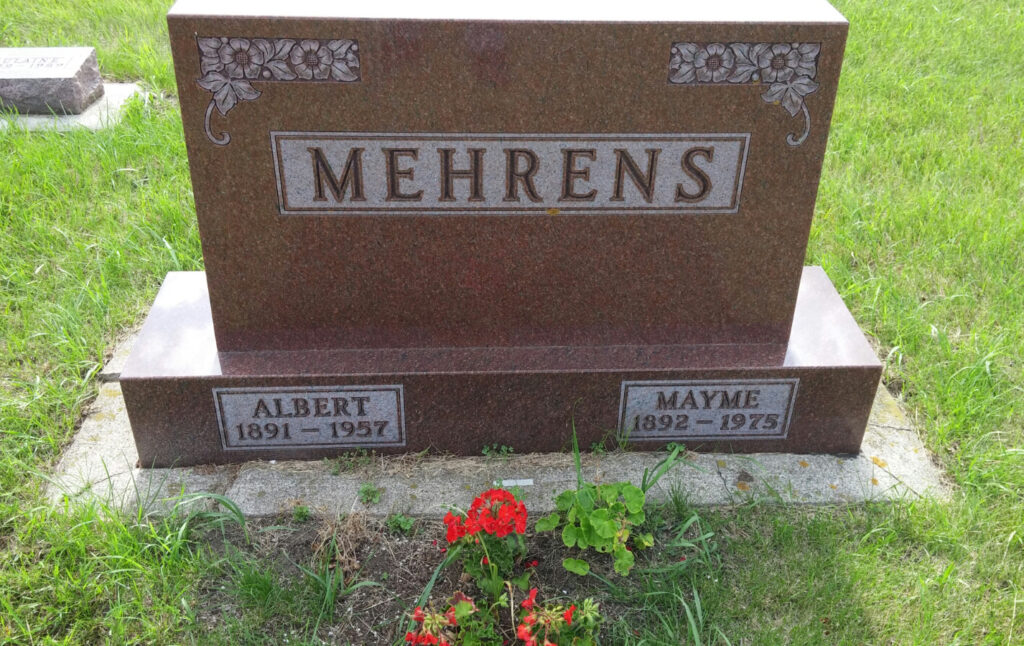
Albert and Mayme retired from the farm to the town of Calumet in 1946. Albert died in 1957 at the age of 66, and Mayme lived for almost another two decades, passing away at age 83 in 1975. They are buried in Liberty Cemetery near Calumet.

Subscribers to Ancestry.com may wish to further explore some family connections of Albert Mehrens by accessing an Ancestry profile page (within the context of a “Mugge Family Tree”).
Connection to Other Band Members
See the biosketch page for John Mehrens (1889-1941), Calumet German Band member and brother of Albert Mehrens.
A future marriage would create an in-law relationship between Albert Mehrens (and his brother John) with William “Bill” Eggers (1886-1968). Albert and John’s brother Elmer William Mehrens (1897-1955) in 1924 married Alice Meier (1906-1982), who was a niece of Bill Eggers. Alice was the daughter of Bill’s sister Amanda Eggers (1884-1938) and Edward W. Meier (1878-1913). See a schematic of this relationship.
And there is a complex family connection to band member Henry W. Mugge (1891-1967). Albert Mehrens’s sister-in-law, Matie Rohwer (1880-1954), who was the wife of another brother of Albert and John — Gustave Henry Mehrens (1880-1932) — was a sister of Dorothea Henrietta Rohwer (1872-1925), whose husband Henry Schierholz (1874-1964) was a first cousin of Bernhart “Ben” Schierholz (1882-1962). Ben Schierholz was a brother-in-law of Henry Mugge: Ben’s wife Elizabeth “Lizzie” Emma Kundel (1888-1969) was a sister of Henry Mugge’s wife Lillie Kundel (1892-1960). Again, a schematic, available here, is probably the best way to understand this complicated relationship.
Connection to the Mugges
In addition to the familial connection noted on the previous page, there are also neighbor connections between the Mehrens and Mugge families.
The Mehrens farm where Albert and John were raised was one mile west of the Henry Schallau farm, which beginning in 1952 was farmed by Henry Mugge’s son Lyle John Mugge (1915-2000) and since 1976 by Lyle’s son Paul Henry Mugge (b. 1951).
Additionally, as detailed above, Albert’s wife Mayme Segelke (1892-1975) was a daughter of Bill Segelke (1865-1949) and Mary Anna Wilhelmine Harms (1868-1945). Both the Segelke farm and the Mehrens farm were near that of Johann Hermann Mugge (1865-1931), father of Henry Mugge. (The J. H. Mugge farm was later farmed by other members of the Mugge family.)
Finally, Albert and Mayme’s daughter Mary Ann (1919-1986) married Marvin Curt Fiddelke (1919-2000), who was a first cousin of Herman Carl Fiddelke (1909-1971), a neighbor of Lyle Mugge during his farming career, and the father of Bob, Rich, and Barb Fiddelke. The Fiddelkes were also distantly related to the Mugges.
Footnotes
(1) Some of the opening material for this biosketch repeats information that appears on the bio for Albert’s brother, John Mehrens (1889-1941).
(2) Moisture should generally not exceed 14-15%, and it should be even lower for long-term storage.
(3) The church had been established in 1891 as the German Evangelical Lutheran Church. The word “Lutheran” was dropped from the name in 1920, and at a later point it became the Zion Evangelical and Reformed Church. Still later, upon its joining the United Church of Christ denomination, it became known as the Zion United Church of Christ. It continues under that name to the present day.
